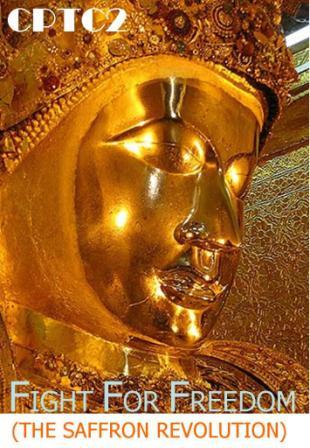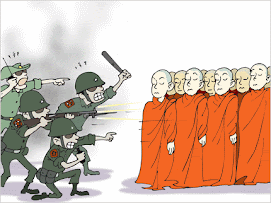
Most Burmese farmers grow monsoon paddy as well as summer paddy.
Paddy cultivation begins with land preparation. In this photo taken in June 2001
in Myaungmya Township of the Irrawaddy Delta region, two bullocks are used in
paddy land preparation. [Photo: ier.hit-u.ac.jp]
The Burmese Road to Ruin
By John Berthelsen and Doug Crets/Asian Sentinel October 19, 2007
With its origins high in the eastern Himalaya Mountains, the Irrawaddy River sweeps down into Burma onto a vast plain. With the Ganges, the Brahmaputra and the Mekong, it is one of the great rivers of Ssoutheast Asia. From where it comes out of the mountains above Myitkyina, it runs along a valley perhaps 1,500 kilometers long.
Most Burmese farmers grow monsoon paddy as well as summer paddy. Paddy cultivation begins with land preparation. In this photo taken in June 2001 in Myaungmya Township of the Irrawaddy Delta region, two bullocks are used in paddy land preparation. [Photo: ier.hit-u.ac.jp]
The Irrawaddy Valley’s surroundings, a giant ring of mountains, bring to mind California’s Central Valley, with its Coast Range to the west and Sierra Nevada to the east. As hot weather, intensive cultivation and a complex irrigation system have made the interior of California the greatest agricultural producer in the world, the conditions exist to make the Irrawaddy Valley the breadbasket of Asia, rivaling the output of Vietnam, which currently holds that title. It is an unfortunate fact that it isn’t and won’t be, despite the fact that in 1949 the British colonial government bequeathed the most prosperous economy in Asia to Burma’s people on independence.
Hamstrung by a vicious and backward government, Burma’s prosperity has long since vanished. The valley, once the heart of its agricultural prosperity, remains one of the poorest regions in Asia, which has been exploding economically for decades. Burma ranks 23rd in purchasing power parity among the 26 countries that make up East Asia. Only North Korea, Afghanistan and East Timor are below it. Along with Zimbabwe and North Korea, there is no better example in the world of how a government can beggar its people for no other reason than to stay in power.
As an indication of just how wrongheaded government policy can be, Japanese researchers at the Institute of Economic Research at Hitotsubashi University in a 2004 paper described a household survey conducted in 2001, covering more than 500 households in eight villages with diverse agro-ecological environments. They found that the farther they got from the center of the village, where government authority is stronger, the richer the villagers were. Second, the researchers found, farmers and villages emphasizing a paddy-based, irrigated cropping system had lower incomes than those who didn’t.
“The reasons for these paradoxes are the distortions created by agricultural policies that restrict land use and the marketing of agricultural produce,” the researchers found. “Because of these distortions, the transition to a market economy in (Burma) since the late 1980s is only a partial one. The partial transition, which initially led to an increase in output and income from agriculture, revealed its limit in the survey period.”
In other words, the farther villagers got from the government, the better off they were.
It was the disconnect between the government and the people’s livelihood that resulted in the explosion of discontent that caused hundreds of thousands of protesters to take to Burma’s streets in September and early October after the government, without warning, increased fuel prices five-fold for a people so poor many cannot even afford public transport fares. It was a common sight even before the protests to see lines of automobiles on side streets and some main thoroughfares waiting for petrol, stashed away in black market barrels and openly distributed in full view of the military. Burma’s GDP per person is just US $1,800 annually—compared to neighboring Thailand, which it closely resembles culturally and geographically, with a per capita GDP of $9,200—more than five times as much.
In fact, any comparison between Thailand and Burma points up the miserable impact of the military rule imposed on the country since 1962. Life expectancy in Thailand is 72.5 years, compared to just 62.2 years for the average Burmese. Burma’s infant mortality rate is more than 50 per 1,000 live births, compared to 18.5 for Thailand.
From a train pulling out of Mandalay, Burma’s canals are streaked with fuel, with sooty cattails and spotty lotus flowers that appear to be growing in pits of tar. Children run alongside the train, many of them badly crippled, begging as they leap over mud puddles and around burning barrels of trash. Hundreds of thousands of hectares of rice paddies glimmer in the moonlight. Although the brilliant green of the rice paddies is stunningly beautiful in the morning sun, it belies the poverty. There are no tractors. Hundreds of water buffalo still dot the landscape.
A trip to Bagan to see the famed temples is a trip back through time. Horse carts and buses that look like they must have been built during World War II still throng the roads. To the western side of the valley, high up at the very top of the hill in the impossibly clear blue air, there is a shining white temple. It is possible to take a boat across the river and climb up on a trail so steep it resembles a ladder. On each side of the trail, stretching to both the north and the south, are what appear to be troughs, perhaps 20 x 45 centimeters deep, dug into the side of the mountain ascending towards the temple.
Asked what they were, a guide said the Tatmadaw, Burma’s military, fly to the temple by helicopter. At some point they decided that the side of the mountain would be more attractive if it were vegetated with trees. So they dragooned the villagers into forced labor, hanging by ropes to dig the trenches and plant trees. Of course, in a valley that gets perhaps 35 inches of rainfall per year, not a single one of those trees appears to have lived.
That is typical of the approach to agriculture that the government put into place. One study found a disheartening litany of problems from the level of the farm itself up to the national government. There is a general lack of investment for agricultural chemicals including fertilizers and pesticides, water and fertilizers are badly managed, there is limited knowledge on pest and disease control, almost no use of modern farm implements and machinery. There is almost no access to market information.
At the government level, agricultural research is weak and the extension system is antiquated, officials are inadequately trained, especially for rice and rice-related science and technology, despite the fact that Burma remains the highest per-capital milled rice consumer in the world (another sign of poverty as diets have diversified in the rest of Asia). There is inadequate agricultural infrastructure all the way from farm roads to electricity and warehouse and milling factories, both in the public and private sectors. The night-time trip by train from Mandalay to Rangoon is dramatic evidence of the country’s primitive electricity system. The countryside is virtually black, with no lights showing.
Other than the Japanese paper, there appear to be few other recent scholarly studies of Burma’s agriculture system. But according to a 2002 study by the Land Tenure Center of the University of Wisconsin, it would be difficult to find a government that could screw up its policies much worse.
In 1990, after four decades of disaster under the dictator Gen Ne Win, who instituted the Burmese Way to Socialism and forced foreign businesses out of the country and confiscated their assets, the State Law & Order Restoration Council (SLORC), which took over from Ne Win, took total control over all land, targeting self sufficiency in edible oils and increased production for export of several crops. The State Peace and Development Committee, the new name the junta gave itself in 1997, tried new approaches, giving control of the Agriculture Ministry to military officials and supporters, the Wisconsin study noted.
One of its most significant efforts was to invite national entrepreneurs to push large-scale farming on thousands of hectares of land. Entrepreneurs who undertook cultivation of 5,000 acres (2,023 hectares) were granted 30 year leases and permission to export 50 percent of the crops and sell the rest within the country. Tax exemptions were granted for imported machinery, insecticides and fertilizer. Infrastructure, including roads, bridges, telecommunications and wells were to be provided at no cost.
There is little sign that any of it worked. Burma continues to suffer from stifling government control that contributes to grinding poverty. All evidence points to the supposition that an attempt to introduce the widespread use of hybrid rice in the last couple of years was a disaster, without fertilizers, pesticides or training for the farmers in how to cultivate it.
“Lacking monetary or fiscal stability, the economy suffers from serious macroeconomic imbalances including rising inflation, fiscal deficits, multiple official exchange rates that overvalue the Burmese kyat, a distorted interest rate regime, unreliable statistics, and an inability to reconcile national accounts to determine a realistic GDP figure,” according to the latest entries in the CIA World Factbook, dated October 4, 2007. That, of course, was just two weeks ago.
Friday, October 19, 2007
Posted by
CINDY
at
11:24 AM
![]()
Subscribe to:
Post Comments (Atom)





























No comments:
Post a Comment